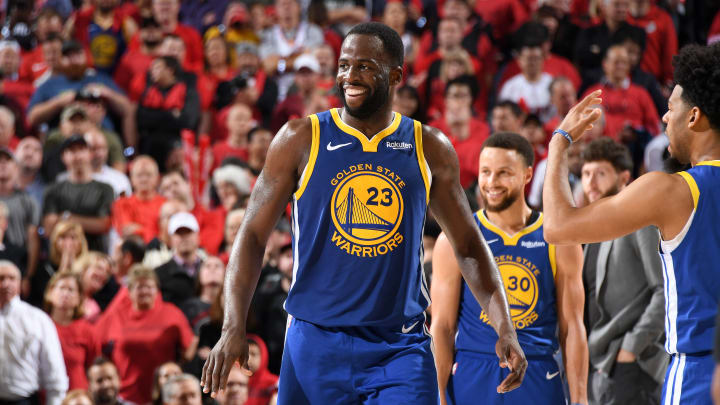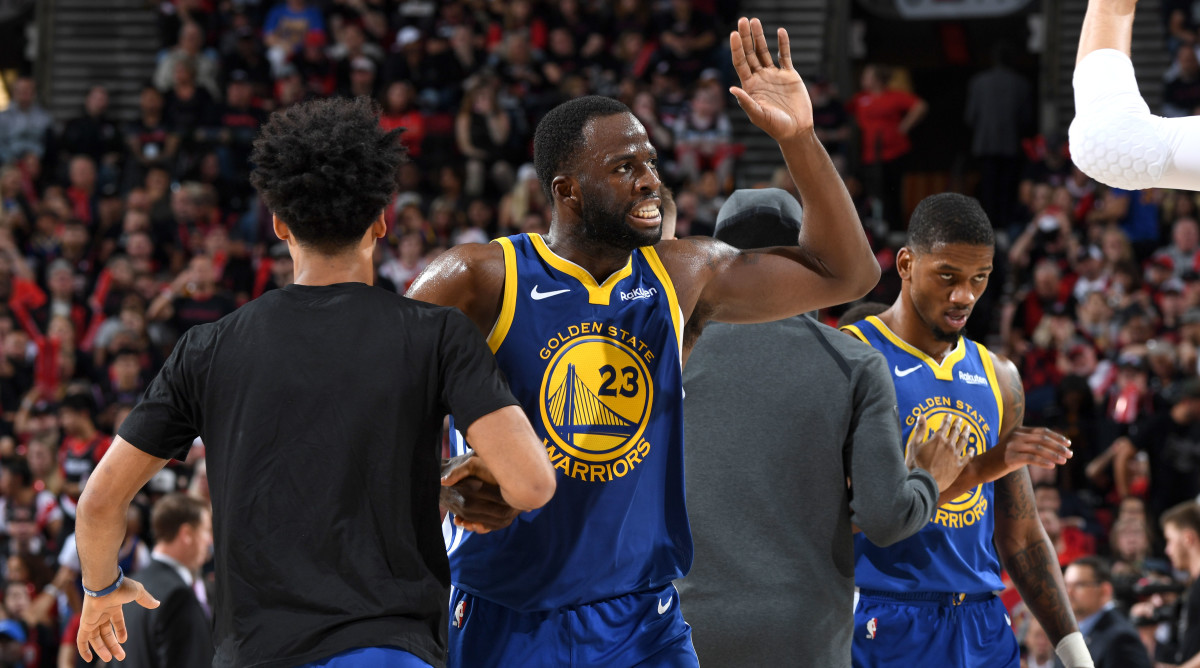The 16-Game Player: Why Draymond Green Thrives in the NBA Playoffs

This story appears in the June 3, 2019, issue of Sports Illustrated. For more great storytelling and in-depth analysis, subscribe to the magazine—and get up to 94% off the cover price. Click here for more.
The Trail Blazers had one last shot to save their season, and only two realistic options. Damian Lillard and CJ McCollum are among the most elusive scorers in the league, with moves not easily predicted and intentions not easily pinned down. No matter the direction of the final inbounds pass with 3.3 seconds left, the ball would ultimately find one of those two. All the Warriors had to do to end the series in Game 4 of the Western Conference finals—and punch their ticket to a fifth straight NBA Finals—was cover both without the slightest lapse.
Shooting guard Klay Thompson, a second-team All-Defense selection, was tasked with shadowing Lillard, as he had throughout the night. Against McCollum, Golden State went with a less conventional choice: Draymond Green. Most bigs would be out of their depth tracking a slippery combo guard for a final shot, but Green isn't most bigs. Even calling the 6'7" 230-pounder one is to accept a positional spectrum that doesn't apply. Over the course of this playoff run he had covered 6'6" combo guard Shai Gilgeous-Alexander, spot-up guard Patrick Beverley and stretch four Danilo Gallinari of the Clippers; small-ball big PJ Tucker and lob-threat center Clint Capela of the Rockets; and point forward Evan Turner and athletic wing Maurice Harkless of the Blazers. The Warriors hadn't cared what position Green guarded then, and wouldn't now. "When you know who the biggest threats are at the end of a game," Golden State coach Steve Kerr says, "you put Draymond on one of those threats."
Green started the play with McCollum but also perfectly executed a switch, disrupted an attempted screen and jammed up a cut to the basket. All Portland could muster was a hard sprint for Lillard to the corner and a turnaround heave that never had a chance. Green may not have defended the shot, but he certainly forced it.

Even a cursory inspection of the playoffs would find them covered with Green's fingerprints. It was his catch-all defense that ended L.A.'s first-round charade, and his playmaking alongside Stephen Curry that dispatched Houston in the second. As the Blazers were swept out, they felt his impact. "Watching him on defense, I mean, it's incredible," said center Meyers Leonard. "His reads, his communication, his weakside defense, blocking shots, steals...."
The Warriors are constantly asked to measure their present against their past. Was this win the most satisfying? The most fun? Has Curry ever been more dangerous? They have learned to sidestep the premise: Five years of setting records and winning titles comes with too many high-water marks to single one out. Mention Green, however, and the superlatives come unprompted. "Just phenomenal," says Kerr. "He's playing as well as he's ever played."
The only players in NBA history to make it to the Finals while averaging as many points (13.6 per game), rebounds (9.9) and assists (8.2) during the playoffs as Green are Wilt Chamberlain, Magic Johnson and LeBron James. Reaching those marks required Green to nearly double his scoring output (7.4) from an underwhelming regular season while boosting his all-around production and efficiency. "This is what you play for," the 29-year-old Green says. "This is what you train for, to be at your best at this time of year, to try to win a championship. When you look at it from that standpoint, which is the way I look at it, it makes it a lot easier to step up to that challenge, because you're playing for something so much bigger than to win that game."
Keeping perspective is a skill, perhaps Green's best. With Kevin Durant sidelined by a right-calf strain, Golden State needs Green at full bore to keep defenses on their heels. He has to attack without pressing—scoring enough to pull attention away from Curry and Thompson without disrupting the offense. "If I'm wide open and Klay is half open, I think it's still a better shot if I give the ball to Klay," Green says.
There is no divorcing the competitor from the contradictions. A player as analytical as Green can strive to make the right play only to lash out at a teammate or retaliate against an opponent. A certain amount of collateral damage comes with being a confrontational personality in a passive-aggressive league. "There's gonna be a couple times a year where he snaps and goes overboard," Kerr says. "That's a small price to pay for getting the intelligence and the competitiveness that he brings."
When opponents test Green by leaving him open at the three-point line, he reads the situation as multiple choice. Rather than shoot—and indulge a weakness—why not drive straight at the rim to force a rotation? Or why not run toward Curry or Thompson for a dribble handoff and send the defense into a frenzy? Part of what makes Green so effective is that he knows exactly who he is, and exactly how fortunate. "He's self-aware enough to know and admit that if he wasn't playing with Steph and Klay, he wouldn't be nearly as good offensively," Kerr says. For a player so mindful of his own limitations to be as confident (or arrogant?) as Green is should unnerve everyone he plays against—the Raptors included. Even now, with a dynasty in full swing, he must know something they don't.

There is no greater testament to Green's influence than the fact that a defense might choose not to force the ball out of Curry's hands on a pick-and-roll with Green, preferring instead to try their luck with the greatest shooter in the known universe. The threat of Green rolling downhill, four-on-three, is too frightening. Stopping his roll means allowing him the lob to Kevon Looney or Andre Iguodala. Hugging in from the edges leaves open a shooter. Given room, Draymond will make the correct decision with destructive frequency. It's the weight of that counterbalance that keeps the defense from tilting too far toward Curry, allowing him to shoot 16% better (by effective field goal percentage) when sharing the court with Green.
"He relieves so much pressure for me and Steph, being able to play off the ball," Thompson says. "His ability to make plays out of the pick-and-roll is probably the best ever. So he makes us go, especially when you push that pace." And it's Green who puts the Warriors in gear. During the playoffs, they have played seven possessions faster per 48 minutes with Green in the game—roughly the difference between the fastest and slowest teams in the league in the regular season. Portland never found an answer for Green ripping a rebound and leading the charge up the floor. There is so much pressure to quickly locate Curry and Thompson in transition that lanes to the basket go unattended. "There's not a lot of big guys that can stay in front of him full-steam ahead in transition," Curry says.
"I just try to take it upon myself to do my part and also try to create a pace that I know we can be successful at," Green says. "I know when we get the game at our pace, not many teams can play with us."
This instinct may seem small, particularly in the complicated tapestry of a series. It isn't. Some veterans need years to learn the magnitude of a playoff possession. It's easy to let one slip—to miss a box-out, get hung up on a screen or jog through a cut—and jeopardize a season in the process. So Green is sprinting the floor off a made basket, on the off chance that a defender might slide a few feet in his direction. The margins can be that thin. Six of Golden State's eight wins against Houston and Portland came by two possessions or fewer. How many of those games were swung because Green treated a random play in the second quarter as if it were the most important moment of his life?
"That's my mind-set going into a game," Green says. "It's the playoffs. If you can't raise the level now, why do you do this?"
Maybe the question is best answered with a bit of his own wisdom. In the lead-up to the 2018 draft, Green—who sat in on the Warriors' predraft process from workouts to the war room—shared a simple idea with the front office: There are 82-game players, and there are 16-game players. Already, the adage has spread around the league, a fascinating extension of Draymond's legacy. The messenger just happened to be the perfect avatar.
"He's a better 16-game player than an 82-game player," Kerr says. "It's because one of his biggest strengths is his competitive energy. His defensive awareness, when you combine it with the energy that comes with a playoff game, it elevates his game to incredible heights." The reality, however, is that the bulk of NBA basketball isn't played at Green's competitive wavelength.
"In the 82-game season, it's more suited to the skill guys—the guys who are great shooters or whatever, guys who rack up big numbers," Kerr says. "And that's not Draymond. He gets triple doubles, and that's the one statistical thing that jumps out about him, the array of boxes that he checks. But during the 82-game season, he gets a little bored and he can't rely on skill, so he gets a little frustrated at times."
For months on end, the Warriors could only play in games of nominal importance, none especially rewarding or challenging. Green looked at times injured, slow, agitated, or disinterested. Some wondered if his athletic decline had already come. Then, in the fire of the playoffs, he was born again.
